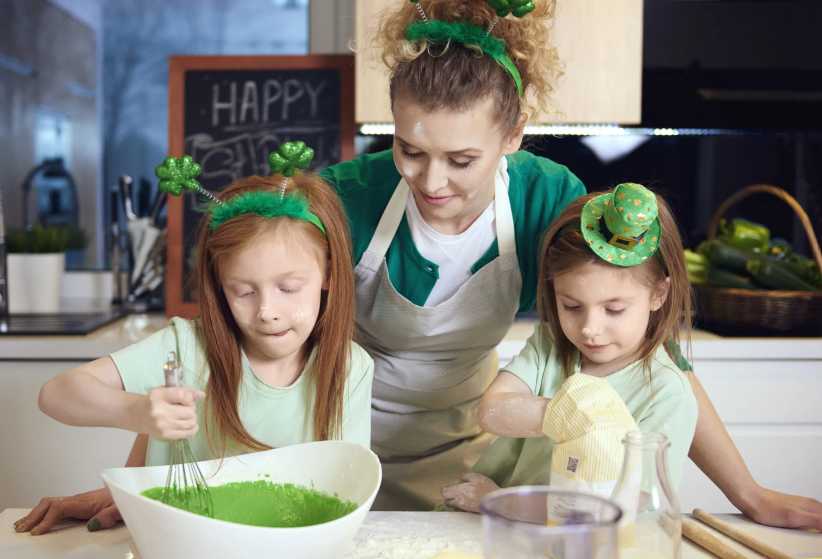Memories of her family’s garden and seasonal harvests in Michigan, coupled with the garden-to-table approach of her mother’s cooking and the important family ritual of enjoying meals together inspired Jenny Gensterblum’s culinary curiosity. This curiosity bloomed into a passion that led her to the French Culinary Institute in New York City, and later, to the restaurant and private chef world. Gensterblum has since shifted her professional focus after seeing a need for change in school food programs. Since 2007, she has worked as the executive chef at Leman Manhattan Preparatory School, and created a program that focuses on balanced, nutritious, and, most importantly, flavorful cuisine for school-age children.

We caught up with Gensterblum to discuss how we can make school lunches healthier–both in the lunchbox and in the cafeteria–and some of her favorite kid-friendly recipes.
The US is notoriously known for having less healthy school lunch programs compared to other first world countries. What are the first steps to making school lunches healthier?
The importance of access to fresh food for all children cannot be overstated. In terms of health, one in three children in America today are overweight or obese, with all the associated health problems that go with it. In terms of learning, being hungry at school can make it difficult to concentrate. Eating a poorly balanced meal can lead to issues with mood and behavior in the classroom. Furthermore, learning what a balanced meal looks like and what fresh fruits and vegetables taste like are important lessons that can last a lifetime, and potentially affect future generations.
The first step to making changes in this pattern is to have everyone’s support. That means that the parents, faculty, and administrators have to be on board. It’s important for adults to model the behavior we want our students to follow, as well as receive help from the parents reinforcing those behaviors at home. Administrators need to believe that healthy eating is an important part of a child’s education, and invest appropriately in the cause.
Are there any specific foods you highly recommend for a certain meal? Are there any food groups that kids should stay away from at night?
A healthy breakfast needs to give you energy and keep you feeling satisfied throughout the morning. Foods with whole grains, protein, and fiber work the best.
Eating a well-balanced lunch helps you concentrate and function in the afternoon (and avoid that midday dive), as well as prevent hunger that could lead to overeating at dinner. For a well-balanced meal, variety is key. Try to have at least one whole-grain carbohydrate, some protein, and both fruits and vegetables.
Children should avoid the obvious at night: sugar, caffeine, or overly salty or heavy snacks. If necessary, have a mix of foods that contain tryptophan (nuts, seeds, cheese, milk) and complex carbohydrates (whole-grain crackers, whole-grain cereal).
What are some tips that you have for on-the-go parents that want to make sure the lunch they pack for their child is healthy?
Packing nutritious lunches everyday for your family is no small task. It takes work and commitment, so there really aren’t any shortcuts. You have to be willing to invest some time in the task! That said, here are some tips for making sure the lunches you pack are healthy:
- Planning is key! The last thing you want is to be rushing around, because that’s the time when you might grab something that’s convenient (and potentially unhealthy). Make a menu for the week, and shop ahead.
- Make extra dinner for leftovers, and then reinvent it! If you’re having roasted chicken, broccoli, and salad for dinner, prepare a little extra. Turn the chicken and salad into a wrap and the broccoli into slaw for lunch the next day.
- Make sure your kids have some input. Take them grocery shopping or ask for their help creating a menu. If they are choosing unhealthy options, let them know to only pick food options from each food group. A balanced lunch should include something from every food group. Children will feel a sense of responsibility and ultimately enjoy their meals more if they have a say.
What are some of your favorite recipes for cooking for kids?
Overnight Oats
Serves 4
Ingredients:
4 containers with lids that fit about 1 cup of ingredients
1 cup steel cut oats
2 teaspoons ground flax seed
2 cups milk (substitutes: almond, rice, soy, or coconut milk)
zest of 2 lemons
1 teaspoon cinnamon
1 teaspoon vanilla extract
2 cups sliced strawberries, blueberries, or other favorite fruit
In a bowl, whisk together milk with flax seeds, zest, cinnamon, and vanilla extract. In each of four jars, place 1Ž4 cup of oats. Top with approximately 1Ž2 cup of the milk mixture. Stir to combine. Top with fruits, cover, and refrigerate overnight.
Vegetable & Nut-Free Pesto Flatbreads
Serves 4
For the Pesto:
1/2 can chickpeas (15.5 ounce can), rinsed and drained
3 cloves garlic
2 cups fresh basil leaves, packed*
Juice from 2 lemons
1/2 cup olive oil
2 tablespoons shredded parmesan (optional)
Salt & Pepper
For the Flatbreads:
4 whole wheat pitas
2 cups of your favorite cooked vegetables (try sautéed kale or spinach, roasted asparagus, steamed broccoli, etc.)
For the Pesto:
Preheat oven to 300°F. Toss chickpeas in salt & pepper. Roast for 20-30 minutes, until golden brown. Let cool.
Put garlic and basil into a food processor. Pulse several times until blended. While the food processor is running, add the lemon juice. Slowly drizzle in the olive oil. Turn off the food processor and scrape the sides of the bowl. Add parmesan cheese, if using, and pulse again until blended. Season with salt and pepper to taste.
For the Flatbreads:
Preheat oven to 425°F.
Lay pita on two baking sheets. Top with pesto as you would pizza sauce. Spread 1/2 cup vegetables on each pita. Bake until crispy and beginning to brown, about 10-15 minutes. Cool and cut into wedges.















